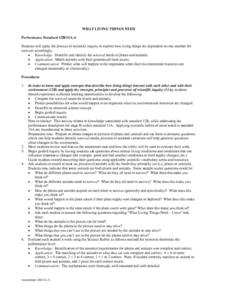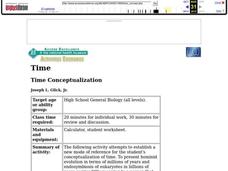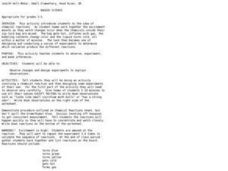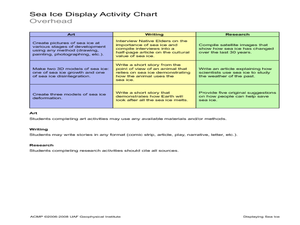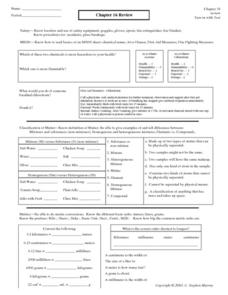Curated OER
Inventing and Presenting Unit 3: Persuasive Speaking and Invention Promotion
Middle schoolers write a proposal for a speech. Students prepare appropriate visuals for use in the proposed speech. Middle schoolers produce one or more graphs that summarize the results from the experimentation. Students deliver an...
Curated OER
Bird airport control
Students identify the various species of birds found in the wetlands. Students observe and record the key skills involved in scientific inquiry. Students handle and interpret data gathered on a field trip which reveals patterns and...
Curated OER
What Living Things Need
Students apply the process of scientific inquiry to explore how living things are dependent on one another for survival. They match animals with their generalized food source. Students predict what happens to the organisms when their...
Curated OER
Creek Restoration Project
Students gather and analyze scientific data from a local creek. Over weeks or months, students observe their local environment, collect water samples, and evaluate test results. Extension activities are suggested for evaluating...
Curated OER
What Do Scientists Do?
Middle schoolers do a report on distinct scientific fields using the Internet resources provided. They see the connection between what they learn in the classroom and what goes on in the enterprise of science.
Curated OER
Let's Measure the Speed of Sound
Third graders measure the speed of sound using scientific investigative techniques.
Curated OER
Oobleck
Students examine states of matter. In this solids and liquids lesson, students conduct a scientific investigation that requires them to make oobleck and record their observations pertaining to it.
Curated OER
Focusing on Lenses
Students explore scientific observations by examining the parts of a microscope. In this optics lesson, students discuss the importance of a focal point and focal distance when utilizing an optical device such as a microscope. Students...
Curated OER
Excavating the Trash
Students look at a day's accumulation of recyclable trash from first through fifth grade classrooms, not knowing which classes it came from. After setting up a collection sheet for data, students remove items from the receptacle and...
Curated OER
Scientific Thinking
Students participate in four different activities which reinforce an understanding of they way scientists think about the world. They make careful observations of two different pennies, write the procedure for making a peanut butter and...
Curated OER
Combining Elements to Form a Compound
Students explore elements and compounds. In this lesson about elements and compounds, students will do an experiment. Students work in groups of 2-3 as they complete two separate activities. Students understand how two elements combine...
Curated OER
Cells
In this scientific investigation activity, learners follow the provided procedures to examine the number of cells in animals and then respond to 3 short answer questions.
Curated OER
Time Conceptualization
High schoolers use this activity to establish a new mode of reference to the conceptualization of time. To present hominid evolution in terms of millions of years and endosymbiosis of eukaryotes in billions of years carries little...
Curated OER
Woodwind Instruments and Pitch
Students explore musical pitch. In this cross curriculum musical instruments and "sound" physics lesson, students identify and describe common traits of woodwind instruments. Students research "pitch" and what causes pitch fluctuation by...
Curated OER
The Designed World
Learners study the classification system used in a library. In this sorting and classification lesson, students visit their library and define the classification system in place. Learners discuss the sorting method and then come up with...
Curated OER
Baggie Science
Students observe and describe a chemical reaction. For this chemistry lesson, students record observations of the materials they will be using, then follow a written procedure to perform the experiment in a baggie and record their...
Curated OER
Peanut Processes
Students use the senses are to make observations about phenomena. They use a peanut and its shell as the object of a series of observations. In addition, they complete a drawing with their written observations to use as a guide to choose...
Curated OER
Displaying Sea Ice
Students display their knowledge of sea ice. In this earth science lesson, students create displays reflecting their understanding of sea ice.Students research the development of sea ice on a variety of bodies of water, and use proper...
Curated OER
Chapter 16 Review- General Science
For this review of general science worksheet, students classify examples of matter as mixtures or substances, homogeneous or heterogeneous mixtures, or elements or compounds. Students also convert several examples using the standard...
Curated OER
And the Survey Says...
Eighth graders evaluate whether a certain argument is valid or invalid. In this science lesson, 8th graders discuss the importance of using unbiased evidence. They design an experiment that they can test in school.
Curated OER
Magnetism
Students explore physical science by participating in a class science activity. In this magnet attribute lesson, students define a list of scientific vocabulary terms associated with magnets and participate in hands on magnet activities....
Curated OER
Defining the Difference Between Prokaryotic and Eukaryotic Cells
Students examine microscopic life by conducting a scientific investigation. In this cell analysis lesson, students define the prokaryotic and eukaryotic cells and discuss their word origins. Students view each type of cell on slides...
NASA
Melting Ice: Designing an Experiment
Sometimes, despite the best laid plans, the unexpected will occur. Learners witness this firsthand as they carefully design an experiment to determine the time needed for ice to melt in salt water or pure water. They uncover facts not...
Energy for Keeps
Going for a Spin: Making a Model Steam Turbine
Discover the effectiveness of wind, water, and steam as energy sources. The hands-on activity has young scientists create a turbine from common materials. After constructing the turbines, they use wind, water, and steam to turn them and...




